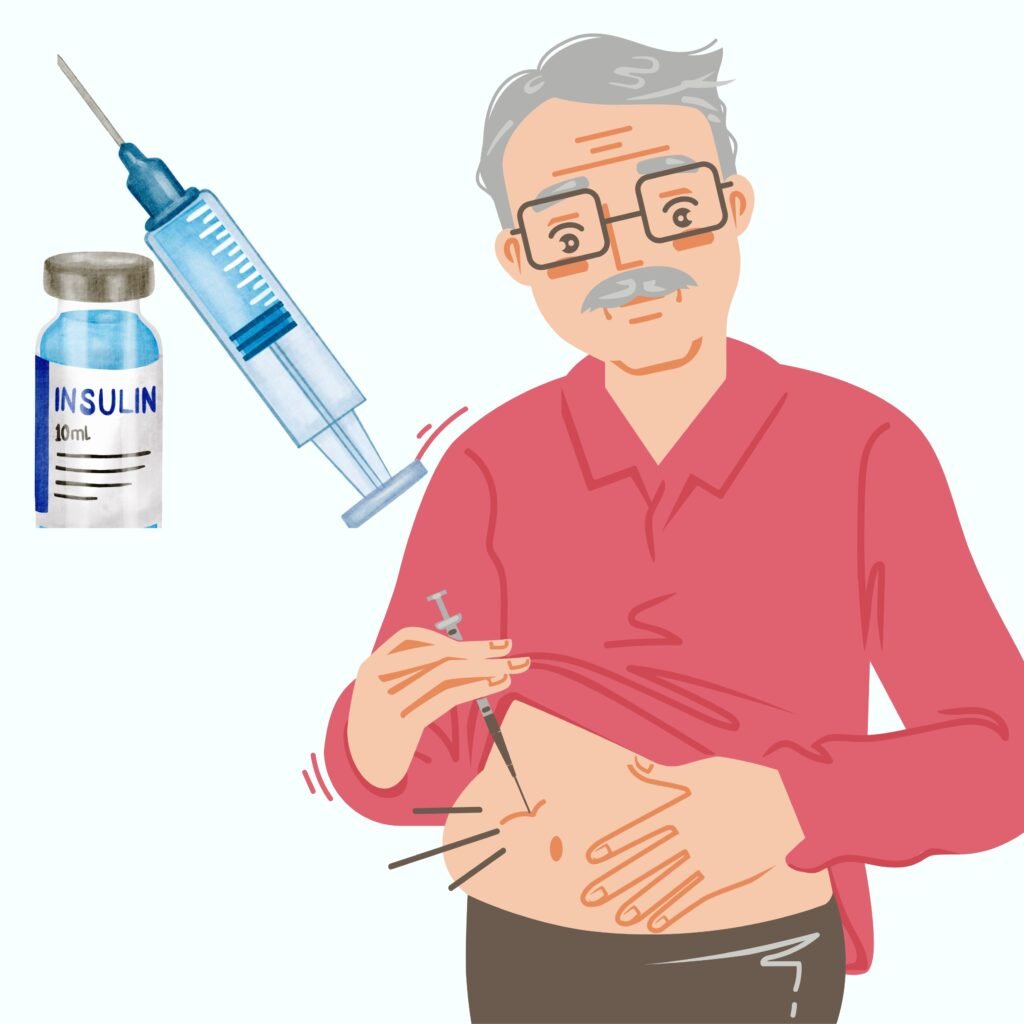Introduction:
Diabetes, also referred to as diabetes mellitus, is a long-term metabolic disease marked by high blood glucose levels. Globally, diabetes prevalence has been rising, which presents a serious public health concern. While nutrition and exercise are important components of diabetes management, pharmacological interventions—particularly antidiabetic agents—are vital for regulating blood glucose levels. The several classifications of anti-diabetic drugs, their modes of action, and their function in the treatment of diabetes will all be covered in this article.
Insulin Therapy:

Blood sugar is regulated by the hormone insulin, which is generated by the pancreas. Type 1 diabetes is caused by insufficient insulin production by the pancreas, while Type 2 diabetes is caused by ineffective insulin cellular response.
Insulin is administered as part of insulin therapy to augment or replace the body’s endogenous production of insulin. It is essential for managing Type 1 diabetes and is also recommended for certain people with Type 2 diabetes.
Oral Diabetes Treatments:
- Sulfonylureas (glipizide, glyburide, gliclazide, glimepiride)
- Meglitinides (repaglinide and nateglinide)
- Biguanides (metformin)
- Thiazolidinediones (rosiglitazone, pioglitazone)
- α-Glucosidase inhibitors (acarbose, miglitol, voglibose)
- DPP-4 inhibitors (sitagliptin, saxagliptin, vildagliptin, linagliptin, alogliptin)
- SGLT2 inhibitors (dapagliflozin and canagliflozin)
- Cycloset (bromocriptine)
NON FDA APPROVES INDICATIONS:
Prevention of Type 2 Diabetes Mellitus (T2DM):
Metformin is sometimes prescribed off-label for individuals with prediabetes or at high risk of developing T2DM to help prevent or delay the onset of the disease. This is often part of a broader lifestyle intervention program.
1) Treatment of Gestational Diabetes Mellitus (GDM):
In cases of gestational diabetes, where blood sugar levels become elevated during pregnancy, metformin might be used off-label to help manage blood glucose levels, either alone or in conjunction with insulin.
2) Treatment of Polycystic Ovary Syndrome (PCOS):
Metformin is commonly prescribed off-label to manage symptoms of PCOS, particularly in women with menstrual irregularities or infertility associated with PCOS. It can help improve insulin sensitivity and regulate menstrual cycles.
3) Prevention of Ovarian Hyperstimulation Syndrome (OHSS) in PCOS Patients undergoing Intra-Cytoplasmic Sperm Injection (ICSI) or In Vitro Fertilization (IVF):
Metformin may be used off-label to reduce the risk of OHSS in women with PCOS undergoing fertility treatments such as ICSI or IVF.
4) Management of Antipsychotic-Induced Weight Gain:
There is evidence to suggest that metformin may help mitigate weight gain associated with certain antipsychotic medications. It may be used off-label in conjunction with antipsychotic treatment to manage weight or prevent further weight gain.
Biguanides, such as Metformin:
For Type 2 diabetes, Metformin is a commonly recommended first-line drug. It functions by lowering the liver’s synthesis of glucose and raising peripheral tissues’ sensitivity to insulin.
Sulfonylureas, such as Glibenclamide and Glimepiride:
These drugs encourage the pancreas to secrete insulin, which lowers blood sugar levels. They are frequently taken with additional anti-diabetic medications.
Thiazolidinediones (Pioglitazone, for example):
These medications improve muscle and adipose tissue’s insulin sensitivity, which improves glucose utilization. Usually, they are employed in the treatment of Type 2 diabetes.
Incretin-Based Therapies:
GLP-1 Receptor Agonists:
These medications, which include exenatide and ligglutide, imitate the effects of GLP-1, a hormone that promotes insulin secretion and inhibits the release of glucagon. Additionally, they slow down the emptying of the stomach, which improves glycemic management.
DPP-4 Inhibitors:
: DPP-4 inhibitors, such as saxagliptin and sitagliptin, raise incretin hormone levels, which improve insulin secretion and lower glucagon levels.
SGLT-2 Inhibitors:
Canagliflozin and Dapagliflozin are examples of SGLT-2 inhibitors. They function by preventing the kidneys from reabsorbing glucose, which increases the amount of glucose excreted in the urine.
Combination Therapies:
To treat several elements of diabetes pathophysiology and maximize glycemic control, medical professionals frequently prescribe a mix of various antidiabetic drugs.
ADVERSE EFFECTS OF ORAL HYPOGLYCEMIC AGENTS:
Sulfonylureas: Syncope (less than 3%), dizziness (2% to 7%), nervousness (4%), anxiety (less than 3%), depression (<3%), hypoesthesia (less than 3%), insomnia (<3%), pain (<3%), paresthesia (less than 3%), drowsiness (2%), headache (2%), diaphoresis (less than 3%), pruritus (1% to less than 3%), hypoglycemia (less than 3%), increased lactate dehydrogenase, diarrhea (1% to 5%), flatulence (3%), dyspepsia (less than 3%), and vomiting (less than 3%).
Repaglinide: Hypoglycemia (16% to 31%), weight gain, headache (9% to 11%), upper respiratory tract infection (10% to 16%), and cardiovascular ischemia (4%).
Metformin: Gastrointestinal upset such as diarrhea (12% to 53%), nausea and vomiting (7% to 26%), flatulence (4% to 12%), chest discomfort, flushing, palpitation, headache (5% to 6%), chills, dizziness, taste disorder, diaphoresis, nail disease, skin rash, vitamin B12 deficiency. Also, in less than 1% of patients, it causes lactic acidosis, which can be life-threatening, and is precipitated by conditions predisposing to hypoperfusion and hypoxemia, such as severe renal failure (eGFR less than 30 ml/min/1.73 m2).
Thiazolidinediones: Edema (less than or equal to 27%), hypoglycemia (less than or equal to 27%), cardiac failure (less than or equal to 8%), headache, bone fracture (less than or equal to 5%), myalgia (5%), sinusitis (6%), and pharyngitis.
Alpha-glucosidase inhibitors: Adverse effects include flatulence (74%) that tends to decrease with time, diarrhea (31%), abdominal pain (19%), and increased serum transaminases (less than or equal to 4%).
DPP4 inhibitors:
- Sitagliptin: Hypoglycemia (1%), nasopharyngitis (5%), increased serum creatinine, acute pancreatitis (including hemorrhagic or necrotizing forms), and acute renal failure.
- Saxagliptin: Peripheral edema (4%), headache (7%), hypoglycemia (6%), urinary tract infection (7%), lymphocytopenia (2%), and acute pancreatitis.
- Linagliptin: Hypoglycemia (7%), increased uric acid (3%), increased serum lipase (8%; more than three times upper limit of normal), nasopharyngitis (7%), and acute pancreatitis.
SGLT-2 inhibitors: Dyslipidemia (3%), hyperphosphatemia (2%), hypovolemia (1%), nausea, fungal vaginosis (7% to 8%), urinary tract infection (6%), increased urine output (3% to 4%), dysuria (2%), influenza (2% to 3%), bone fracture (8%), and renal impairment.
Cycloset: Dizziness, fatigue, headache, constipation, rhinitis, nausea, and weakness.
Conclusion:
Antidiabetic drugs have completely changed the way diabetes is managed, giving medical practitioners a wide range of alternatives to customize treatment regimens to meet the needs of each patient. The field’s continuous research and development is producing new insights and treatment choices, giving people with diabetes hope for better results and a higher standard of living. Future research into diabetes should lead to progressively more precise and successful antidiabetic therapies.





